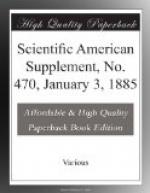In either instrument, the semi-major axis C X is equal to S R, and the semi-minor axis to S P.
The ellipse, then, is described by these arrangements because it is a special form of the epitrochoid; and various other epitrochoids may be traced with Suardi’s pen by substituting other wheels, with different numbers of teeth, for a in Fig. 43.
Another disguised planetary arrangement is found in Oldham’s coupling, Fig. 44. The two sections of shafting, A and B, have each a flange or collar forged or keyed upon them; and in each flange is planed a transverse groove. A third piece, C, equal in diameter to the flanges, is provided on each side with a tongue, fitted to slide in one of the grooves, and these tongues are at right angles to each other. The axes of A and B must be parallel, but need not coincide; and the result of this connection is that the two shafts will turn in the same direction at the same rate.
The fact that C in this arrangement is in reality a planetary wheel, will be perceived by the aid of the diagram, Fig. 45. Let C D be two pieces rotating about fixed parallel axes, each having a groove in which slides freely one of the arms, A C, A D, which are rigidly secured to each other at right angles.
The point C of the upper arm can at the instant move only in the direction C A; and the point D of the lower arm only in the direction A D, at the same instant; the instantaneous axis is therefore at the intersection, K, of perpendiculars to A C and A D, at the points C and D. C A D K being then a rectangle, A K and C D will be two diameters of a circle whose center, O, bisects C D; and K will also be the point of contact between this circle and another whose center is A, and radius A K = C D. If then we extend the arms so as to form the cross, P K, M N, and suppose this to be carried by the outer circle, f, rolling upon the inner one, F, its motion will be the same as that determined by the pieces, C D; and such a cross is identical with that formed by the tongues on the coupling-piece, C, of Fig. 44.
A O is the virtual train-arm; let the center, A, of the cross move to the position B, then since the angles A O B at the center, and A C B in the circumference, stand on the same arc, A B, the former is double the latter, showing that the cross revolves twice round the center O during each rotation of C; and since A C B = A D B, C and D rotate with equal velocities, and these rotations and the revolution about O have the same direction. While revolving, the cross rotates about its traveling center, A, in the opposite direction, the contact between the two circles being internal, and at a rate equal to that of the rotations of C and D, because the velocities of the axial and the orbital motion are to each other as f is to F, that is to say, as 1 is to 2. Since in the course of the revolution the points P and K must each coincide with C, and the points M and N with D, it follows that each tongue in Fig. 44 must slide in its groove a distance equal to twice that between the axes of the shafts.




